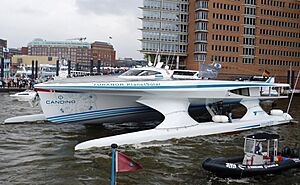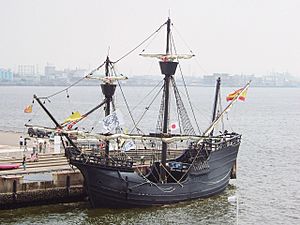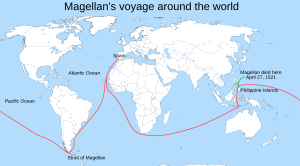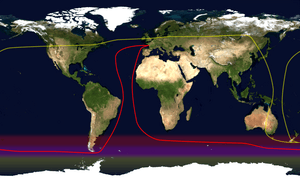Circumnavigation facts for kids
Circumnavigation means traveling all the way around something. When we talk about circumnavigation, we usually mean going all the way around the Earth. It's like drawing a big circle around the planet!
The very first time someone sailed all the way around the world was between 1519 and 1522. This amazing journey was started by Ferdinand Magellan, a Portuguese explorer. He led five ships from Spain, sailing west across the Atlantic Ocean. Along the way, he found a special water path at the bottom of South America. Today, we call it the Strait of Magellan, named after him. Sadly, Magellan died in a fight in the Philippines in 1521. But his journey didn't end there! Juan Sebastián Elcano took over command. He brought one ship and 18 brave survivors back to Spain in 1522. This incredible trip proved that our Earth is indeed a globe.
Contents
Famous Journeys Around the World
Many other explorers and adventurers have followed in Magellan's footsteps. Here are some famous circumnavigations by sea:
- 1577-1580: The English explorer Francis Drake completed the second journey around the world.
- 1586-1588: Thomas Cavendish also sailed around the globe.
- 1598-1601: The Dutchman Olivier van Noort made his own circumnavigation.
- 1614-1617: Georg Spielberg, a German sailing for the Dutch, went around the world.
- 1766-1769: Louis Antoine de Bougainville led the first French circumnavigation.
- 1803-1806: Adam Johann von Krusenstern completed the first Russian circumnavigation.
History of Global Travel
The first single trip around the entire world was by the ship Victoria. This journey, known as the Magellan–Elcano expedition, happened between 1519 and 1522. It was a Spanish voyage of discovery. It began in Seville, Spain, and crossed the Atlantic Ocean. After several stops, the ships sailed around the southern tip of South America. There, they found the famous Strait of Magellan.
The expedition then continued across the vast Pacific Ocean. They discovered many islands, including Guam, before reaching the Philippines. After Magellan's death in 1521, Juan Sebastián Elcano became the leader. He guided the expedition across the Indian Ocean, around the Cape of Good Hope in Africa, and back up the Atlantic Ocean to Spain in 1522. Only Elcano and 18 other men completed the entire journey.
In 1577, Queen Elizabeth I of England sent Francis Drake on an important expedition. He was to sail against the Spanish along the Pacific coast of the Americas. Drake left Plymouth, England, in November 1577, on his ship Pelican. He successfully completed the second circumnavigation of the world in September 1580. This made him the first commander to lead an entire circumnavigation.
By the 1800s, long voyages around the world became possible for wealthy people. Later, new technologies and more money made such trips quite common.
Modern Journeys by Machine

Since 1922, when Cunard's ship Laconia offered the first world cruise, thousands of people have traveled around the globe. These trips are much more relaxed now. The fastest journey around the world by a mechanically powered ship was completed in just over 60 days in 2008.
Flying Around the World
With the invention of commercial airplanes, tens of thousands of people have flown around the world. Some airline routes, like the old Pan American Flight One, used to circle the globe. Today, planning a trip around the world by connecting flights is very easy.
The first successful flight around the planet happened in 1924. It was flown by aviators from the U.S. Army Air Service. They used four special planes called Douglas World Cruisers.
Space Travel Around the World

The very first person to fly in space was Yuri Gagarin. In 1961, he also became the first person to complete an orbital spaceflight in his Vostok 1 spaceship. He circled the Earth from space!
Human-Powered Journeys
Some people have even gone around the world using only their own power!
- 2003: On June 13, Robert Garside finished the first recognized run around the world. It took him five and a half years!
- 2007: On October 6, Jason Lewis completed the first human-powered circumnavigation of the globe. This included crossing oceans by his own power.
- 2012: On July 21, Erden Eruç finished the first solo human-powered circumnavigation of the globe.
Images for kids
-
The red line shows a common path for modern sailing trips around the world, using the Suez Canal and the Panama Canal.
See also
 In Spanish: Circunnavegación para niños
In Spanish: Circunnavegación para niños






